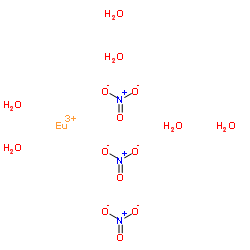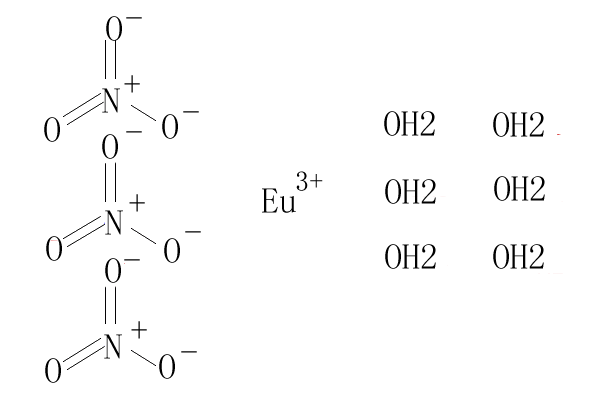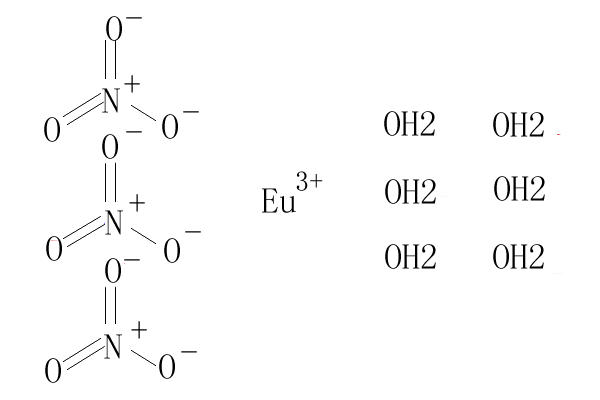硝酸铕(III),六水合物, 99.9% (REO),Europium(III) nitrate hexahydrate
产品编号:西域试剂-WR364083| CAS NO:10031-53-5| MDL NO:MFCD00149700| 分子式:Eu(NO3)3·6H2O| 分子量:446.07
本网站销售的所有产品仅用于工业应用或者科学研究等非医疗目的,不可用于人类或动物的临床诊断或者治疗,非药用,非食用,
| 产品名称 | 硝酸铕(III),六水合物, 99.9% (REO) |
|---|---|
| 英文名称 | Europium(III) nitrate hexahydrate |
| CAS编号 | 10031-53-5 |
| 产品熔点 | 85°C |
| 产品沸点 | 83ºC at 760 mmHg |
| 精确质量 | 446.948029 |
| PSA | 262.02000 |
| LogP | 0.46650 |
| 外观性状 | 白色结晶粉末 |
| 蒸气压 | 49.8mmHg at 25°C |
| 稳定性 | Stable. Strong oxidizer. |
| 储存条件 | 0-6°C |
相关文档
化学品安全说明书(MSDS)
下载MSDS质检证书(COA)
相关产品
| 危害码 (欧洲) | O:Oxidizing; |
|---|---|
| 风险声明 (欧洲) | R8 |
| 安全声明 (欧洲) | S17 |
| 危险品运输编码 | 1477 |
| 包装等级 | III |
| 危险类别 | 5.1 |
Synonym:Nitric acid, europium(3+) salt, hexahydrat Section 2 - COMPOSITION, INFORMATION ON INGREDIENTS
Risk Phrases: 8 Section 3 - HAZARDS IDENTIFICATION EMERGENCY OVERVIEW
Contact with combustible material may cause fire.Hygroscopic (absorbs moisture from the air). Potential Health Effects Eye: May cause eye irritation. May cause conjunctivitis. May cause permanent corneal opacification. Skin: May cause skin irritation. May cause severe irritation and possible burns. Ingestion: May cause burns to the gastrointestinal tract. May cause nausea, vomiting, and diarrhea, possibly with blood. Inhalation: May cause respiratory tract irritation. May cause acute pulmonary edema, asphyxia, chemical pneumonitis, and upper airway obstruction caused by edema. Chronic: Not available. Section 4 - FIRST AID MEASURES Eyes: Immediately flush eyes with plenty of water for at least 15 minutes, occasionally lifting the upper and lower eyelids. Get medical aid immediately. Skin: Get medical aid immediately. Immediately flush skin with plenty of water for at least 15 minutes while removing contaminated clothing and shoes. Wash clothing before reuse. Ingestion: Never give anything by mouth to an unconscious person. Get medical aid immediately. Do NOT induce vomiting. If conscious and alert, rinse mouth and drink 2-4 cupfuls of milk or water. Inhalation: Get medical aid immediately. Remove from exposure and move to fresh air immediately. If not breathing, give artificial respiration. If breathing is difficult, give oxygen. Notes to Physician: Section 5 - FIRE FIGHTING MEASURES General Information: As in any fire, wear a self-contained breathing apparatus in pressure-demand, MSHA/NIOSH (approved or equivalent), and full protective gear. Strong oxidizer. Contact with other material may cause fire. Use water with caution and in flooding amounts. Extinguishing Media: Use water spray, dry chemical, carbon dioxide, or chemical foam. Contact professional fire-fighters immediately. Section 6 - ACCIDENTAL RELEASE MEASURES General Information: Use proper personal protective equipment as indicated in Section 8. Spills/Leaks: Vacuum or sweep up material and place into a suitable disposal container. Clean up spills immediately, observing precautions in the Protective Equipment section. Remove all sources of ignition. Provide ventilation. Section 7 - HANDLING and STORAGE Handling: Wash thoroughly after handling. Use only in a well-ventilated area. Minimize dust generation and accumulation. Avoid breathing dust, vapor, mist, or gas. Empty containers retain product residue, (liquid and/or vapor), and can be dangerous. Keep container tightly closed. Avoid contact with clothing and other combustible materials. Do not get on skin or in eyes. Avoid ingestion and inhalation. Use only in a chemical fume hood. Do not pressurize, cut, weld, braze, solder, drill, grind, or expose empty containers to heat, sparks or open flames. Storage: Keep away from heat, sparks, and flame. Do not store near combustible materials. Store in a tightly closed container. Keep under an argon blanket. Store in a cool, dry, well-ventilated area away from incompatible substances. Store protected from moisture. Section 8 - EXPOSURE CONTROLS, PERSONAL PROTECTION Engineering Controls: Facilities storing or utilizing this material should be equipped with an eyewash facility and a safety shower. Use adequate ventilation to keep airborne concentrations low. Exposure Limits CAS# 10031-53-5: Personal Protective Equipment Eyes: Wear appropriate protective eyeglasses or chemical safety goggles as described by OSHA's eye and face protection regulations in 29 CFR 1910.133 or European Standard EN166. Skin: Wear appropriate gloves to prevent skin exposure. Clothing: Wear a chemical apron. Wear appropriate clothing to prevent skin exposure. Respirators: A respiratory protection program that meets OSHA's 29 CFR 1910.134 and ANSI Z88.2 requirements or European Standard EN 149 must be followed whenever workplace conditions warrant respirator use. Section 9 - PHYSICAL AND CHEMICAL PROPERTIES Physical State: Crystalline powder Color: white crystalline powder Odor: Not available. pH: Not available. Vapor Pressure: Not available. Viscosity: Not available. Boiling Point: Not available. Freezing/Melting Point: Not available. Autoignition Temperature: Not applicable. Flash Point: Not applicable. Explosion Limits, lower: Not available. Explosion Limits, upper: Not available. Decomposition Temperature: Solubility in water: Specific Gravity/Density: Molecular Formula: EuN3O9.6H2O Molecular Weight: 446.07 Section 10 - STABILITY AND REACTIVITY Chemical Stability: Stable under normal temperatures and pressures. Conditions to Avoid: Ignition sources, dust generation, combustible materials, reducing agents, exposure to moist air or water. Incompatibilities with Other Materials: Reducing agents, moisture, thiocyanates, isothiocyanates, cyanides (e.g. potassium cyanide, sodium cyanide), hypophosphites, metal nitrates, organic materials, strong acids. Hazardous Decomposition Products: Nitrogen oxides, carbon monoxide, carbon dioxide. Hazardous Polymerization: Has not been reported. Section 11 - TOXICOLOGICAL INFORMATION RTECS#: CAS# 10031-53-5: LE8050000 LD50/LC50: CAS# 10031-53-5: Oral, rat: LD50 = >5 gm/kg. Carcinogenicity: Europium(III) nitrate hexahydrate - Not listed by ACGIH, IARC, or NTP. Other: See actual entry in RTECS for complete information. Section 12 - ECOLOGICAL INFORMATION Section 13 - DISPOSAL CONSIDERATIONS Dispose of in a manner consistent with federal, state, and local regulations. Section 14 - TRANSPORT INFORMATION IATA Shipping Name: NITRATES, INORGANIC, N.O.S. Hazard Class: 5.1 UN Number: 1477 Packing Group: II IMO Shipping Name: NITRATES, INORGANIC, N.O.S. Hazard Class: 5.1 UN Number: 1477 Packing Group: II RID/ADR Shipping Name: NITRATES, INORGANIC, N.O.S. Hazard Class: 5.1 UN Number: 1477 Packing group: II Section 15 - REGULATORY INFORMATION European/International Regulations European Labeling in Accordance with EC Directives Hazard Symbols: O Risk Phrases: R 8 Contact with combustible material may cause fire. Safety Phrases: S 17 Keep away from combustible material. WGK (Water Danger/Protection) CAS# 10031-53-5: No information available. Canada None of the chemicals in this product are listed on the DSL/NDSL list. CAS# 10031-53-5 is not listed on Canada's Ingredient Disclosure List. US FEDERAL TSCA CAS# 10031-53-5 is not listed on the TSCA inventory. It is for research and development use only. SECTION 16 - ADDITIONAL INFORMATION N/A |









 浙公网安备 33010802013016号
浙公网安备 33010802013016号